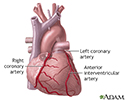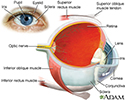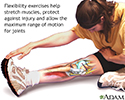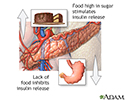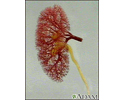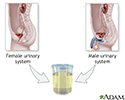Multimedia Gallery
Dialysis
Your kidneys are in charge of filtering wastes out of your blood. But, if your kidneys don't work as well as they should, you may need a procedure called dialysis, a process that removes wastes in place of your kidneys. Let's talk about dialysis.
Your kidneys have several important jobs. In addition to filtering your blood, they help maintain just the right balance of water, acids, and minerals in your body. They also function as part of the endocrine system producing hormones. If you've had kidney disease for many years, or your kidneys have suddenly failed because of disease or injury, your doctor may recommend that you have dialysis, a treatment that replaces some of what the kidneys do, removing waste and excess fluid from your blood. It is sometimes used as a holding treatment while awaiting a kidney transplant.
Here's how dialysis works. First, your doctor will need to create an access to reach your blood vessels. If you need dialysis only for a short period of time, that access will be made using a hollow tube, called a catheter. Usually the catheter is placed into a large vein in your neck, chest, or leg near your groin. If you're having dialysis for a longer period of time, you'll need a more permanent access. To create this access, your doctor will connect one of your arteries to one of your veins. Then whenever you have dialysis, a needle is simply placed into this access area.
During each dialysis session, your blood is removed from your body through the needle. It's sent across a special filter, which removes harmful substances from your blood. Then, your clean blood is sent back into your body.
Often, you'll visit a special center for dialysis about three times a week. Each session lasts three to four hours. Or, you may be able to do dialysis right at home three times a week or even daily. Home sessions are shorter, about 2 to 3 hours, and they're easier for your body to tolerate. Before you perform dialysis at home, a nurse will teach you how to place the needle, how to clean the machine, and monitor your blood pressure during treatment.
It's important when you're having dialysis that you do all of your scheduled sessions. Also, call your doctor right away if you have any problems, like swelling, redness, fever, a drop in blood pressure, or bleeding. These could be signs that you've developed an infection or other complication from your dialysis, and need medical attention.
Dialysis
Review Date: 9/2/2025
Reviewed By: Walead Latif, MD, Nephrologist and Clinical Associate Professor, Rutgers Medical School, Newark, NJ. Review provided by VeriMed Healthcare Network. Also reviewed by David C. Dugdale, MD, Medical Director, Brenda Conaway, Editorial Director, and the A.D.A.M. Editorial team.
Animations
- Blood pressure
- Bunion
- Cataract
- Childhood obesity
- Cholesterol and triglycerid...
- Coronary artery disease
- Depression
- Diabetes
- Diabetes - retinal conditions
- Diabetes and risk of seriou...
- Dialysis
- Erection problems
- Exercise
- Foot pain
- Gallstones
- Glaucoma
- Hardening of arteries
- HbA1c
- Healthy Guide to Fast Food
- Heart attack
- Hypertension
- Hypertension - overview
- Immune response
- Smoking
- Smoking tips to quit
- Stroke
- Stroke
- The goals of proper type 2 ...
- Tobacco use - effects on ar...
- Tracking your blood pressur...
- Type 1 diabetes
- Type 2 diabetes
- Understanding cholesterol r...
- Urinary incontinence
- Urinary tract infection - adults
- Vaccines
- Venous insufficiency
Illustrations
- 15/15 rule
- Abdominal girth measurement
- Abdominal muscles
- Acanthosis nigricans - close-up
- Acanthosis nigricans on the hand
- Acute MI
- Adjustable gastric banding
- Aerobic exercise
- Alpha-glucosidase inhibitors
- Angina
- Anterior heart arteries
- Atherosclerosis of the extr...
- Autonomic Nerves
- Baby bottle tooth decay
- Benefit of regular exercise
- Biguanides
- Blood pressure
- Blood pressure check
- Blood test
- Blood test
- Brain
- Brainstem function
- Calculating body frame size
- Candida - fluorescent stain
- Candidiasis, cutaneous - ar...
- Carotid dissection
- Carotid stenosis - X-ray of...
- Carpal tunnel syndrome
- Cataract - close-up of the eye
- Central nervous system
- Central nervous system and ...
- Cerebellum - function
- Childhood obesity
- Children's diets
- Cholesterol
- Cholesterol producers
- Circle of Willis
- Circulation of blood throug...
- Complex carbohydrates
- Coronary artery blockage
- Coronary artery disease
- Creatinine tests
- DASH diet
- Dermatitis - reaction to tinea
- Dermatitis - stasis on the leg
- Developmental process of at...
- Diabetes and exercise
- Diabetes and nerve damage
- Diabetes risk factors
- Diabetic blood circulation ...
- Diabetic emergency supplies
- Diabetic foot care
- Diabetic foot care
- Diabetic nephropathy
- Diabetic retinopathy
- Different types of weight gain
- Digestive system
- Endarterectomy
- Endocrine glands
- Energy levels
- Exercise - a powerful tool
- Exercise 30 minutes a day
- Exercise and age
- Exercise and heart rate
- Exercise can lower blood pr...
- Exercise with friends
- Eye
- Fast food
- Fasting plasma glucose test
- Female reproductive anatomy
- Female urinary tract
- Femoral nerve damage
- Fish in diet
- Flexibility exercise
- Follicle development
- Folliculitis - decalvans on...
- Folliculitis on the leg
- Food and insulin release
- Food label guide for candy
- Food label guide for whole ...
- Foot swelling
- Fruits and vegetables
- Fungus
- Gestational diabetes
- Gingivitis
- Gingivitis
- Glaucoma
- Glucose in blood
- Glucose test
- Granuloma - fungal (Majocchi's)
- Granuloma - fungal (Majocchi's)
- Granuloma annulare - close-up
- Granuloma annulare on the elbow
- Granuloma annulare on the eyelid
- Granuloma annulare on the legs
- Hair follicle anatomy
- Hammer toe
- Healthy diet
- Healthy diet
- Heart - front view
- Heart - section through the...
- Heart attack symptoms
- High blood pressure tests
- Influenza
- Influenza vaccines
- Ingrown toenail
- Insulin production and diabetes
- Insulin pump
- Insulin pump
- Islets of Langerhans
- Isometric exercise
- Jaw pain and heart attacks
- Kidney - blood and urine flow
- Kidney anatomy
- Kidneys
- Left cerebral hemisphere - ...
- Lifestyle changes
- Lipocytes (fat cells)
- Low blood sugar symptoms
- Male urinary system
- Male urinary tract
- Monitoring blood pressure
- myPlate
- Nail infection - candidal
- Necrobiosis lipoidica diabe...
- Necrobiosis lipoidica diabe...
- Nervous system
- Nervous system
- Normal uterine anatomy (cut...
- Obesity and health
- Omega-3 fatty acids
- Oral glucose tolerance test
- Osmolality test
- Pancreas
- Pancreas and kidneys
- Pelvic laparoscopy
- Pesticides and fruit
- Pharmacy options
- Physical activity - prevent...
- Pituitary and TSH
- Plaque buildup in arteries
- Pneumococcal vaccine
- Post myocardial infarction ...
- Posterior heart arteries
- Prevention of heart disease
- Progressive build-up of pla...
- Proteins
- Quitting smoking
- Radial nerve dysfunction
- Read food labels
- Retinal dye injection
- Right cerebral hemisphere -...
- Ringworm - tinea corporis o...
- Ringworm - tinea corporis o...
- Ringworm - tinea manuum on ...
- Ringworm - tinea on the han...
- Ringworm of the scalp
- Ringworm, tinea capitis - c...
- Roux-en-Y stomach surgery f...
- Salad nutrients
- Saturated fats
- Secondary infection
- Simple carbohydrates
- Slit-lamp exam
- Smoking hazards
- Sources of fiber
- Soy
- Stable angina
- Starchy foods
- Stein-Leventhal syndrome
- Stomach
- Stomach disease or trauma
- Stye
- Sulfonylureas drug
- Surface anatomy - normal palm
- Surface anatomy - normal wrist
- Swollen gums
- Thiazolidinediones
- Thyroid uptake test
- Tinea corporis - ear
- Tinea versicolor - close-up
- Tinea versicolor - close-up
- Tinea versicolor - shoulders
- Tinea versicolor on the back
- Tooth anatomy
- Tooth anatomy
- Trans fatty acids
- Type I diabetes
- Ulnar nerve damage
- Untreated hypertension
- Urine sample
- Uterus
- Vaginal discharge
- Visual field test
- Vitiligo
- Vitiligo - drug induced
- Vitiligo on the back and arm
- Vitiligo on the face
- Weight loss
- White nail syndrome
- Wood's lamp test - of the scalp
- Wrist anatomy
- Xerosis - close-up
- Yeast and mold
- Yeast infections
- Yoga
- Yo-yo dieting

 Bookmark
Bookmark















































